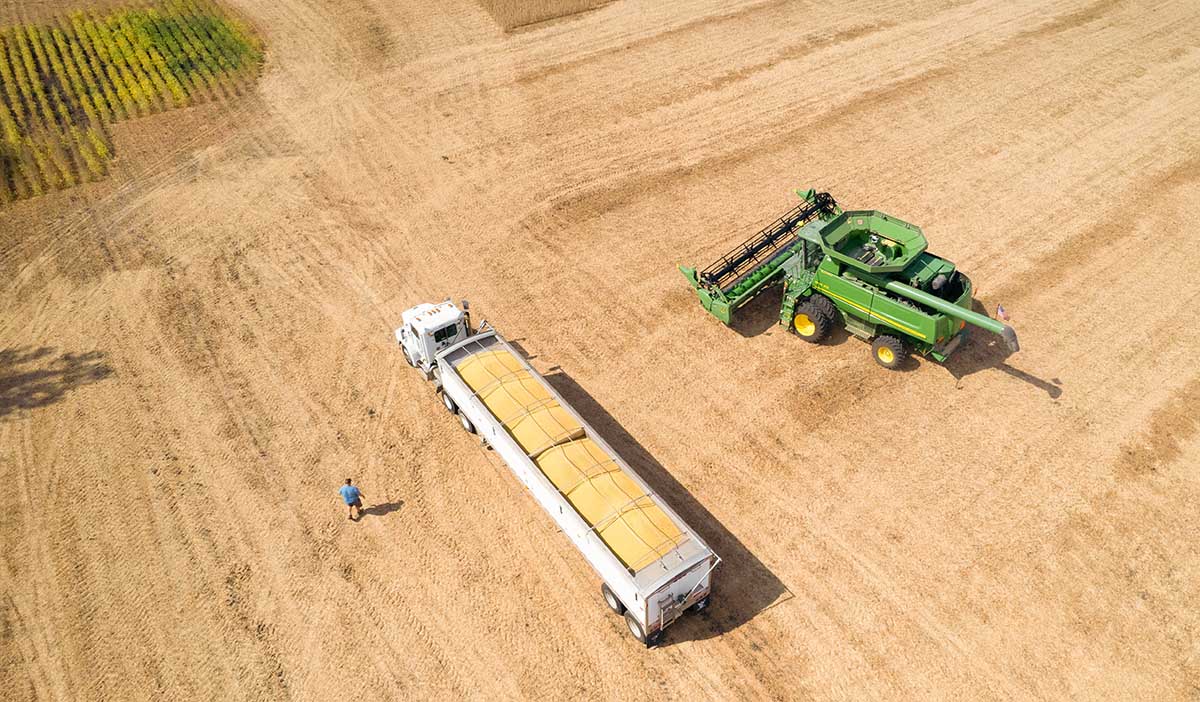
(Photo: Iowa Soybean Association / Joclyn Kuboushek)
Forget the broad brush: This farm economy demands precision
October 9, 2025 | Aaron Putze, APR
Is it the 1980s all over again for U.S. agriculture?
A respected farm lender answers an emphatic, “No.”
In fact, the analogy is misleading and even a bit dangerous, says Jim Knuth, senior vice president for Farm Credit Services of America.
“The 1980s was the perfect storm featuring high interest rates, highly leveraged farms, falling land prices and no crop insurance as a safety net,” says Knuth.
A comparison of 1985 vs 2025 makes Knuth’s point…
- Double-digit interest rate increases vs. decreasing single digit interest rates.
- Little-to-no crop insurance coverage vs. robust crop insurance coverage options with extremely high farmer participation rates.
- Highly leveraged farms with rising debt-to-asset ratios vs. lower debt levels financed at much lower interest rates.
But make no mistake: the current U.S. soybean trade impasse with China ranks among the top three all-time supply-demand disruptions impacting ag, says Knuth. The others: The Russian grain embargo of the 1970s and grain ethanol boom starting in 2008.
“You can’t overstate the impact of going from 20 to 25 percent of the U.S. soybean crop being sold to China to zero,” he says, “which is why we hope we get movement on this issue in the coming weeks.”
Given the many variables currently impacting agricultural returns, Knuth says the equation for examining a farm’s financial strength has changed.
“Often, it’s the market price of soybeans or corn multiplied by the number of bushels plus federal support that will tell the story,” he says. “This year, it’s that, plus whether you applied fungicides plus your risk management decisions.
“So, you have this five-part equation that necessitates a farm-by-farm conversation,” says Knuth. “The broad brush is not applicable.”
The best advice for navigating the economic downturn is the actions of successful operators. Examples shared by Knuth:
- Focus on maximizing profit or worst case, minimizing loss rather than maximizing yields or just cutting costs. “Doing the latter can really come back to bite you,” says Knuth. “You can focus on yield and not allocate wisely or look at productions costs and not purchase the products you need.”
- Understand the financial impact of every business decision. Think through every scenario and act with the end in mind.
- Prioritize working capital. “It’s critical in today’s business environment,” says Knuth. “It’s the farm savings account you draw from when times are tight. Can you add to or maintain it? Do you know the burn rate when you have to access it? It’s difficult to run a business without working capital.”
- The stability of land prices, says Knuth, provides balance sheet stability, but doesn’t correlate to cash flow. “Land equity is good, but it doesn’t solve cash flow issues or repay loans. It’s revenue generated by farm assets, not their value, that pays the bills.”
Proactive Operational Adjustments
Knuth recommends farmers make or consider proactive operational adjustments prior to meeting with lenders this winter. Examples include:
- Identify and sell non- or underperforming assets.
- Utilize assets or personal skills and interests to create new income streams. For example, consider custom farming or trucking as a complimentary business to the farming operation. Or, if you have knowledge and interest in farm equipment and its value, become a broker or join the team of an auction company.
- Put underutilized assets to work. Rent out buildings or storage no longer in use or seek a buyer for a grain bin that can be deconstructed and put to use as a bulk feeding tank.
- Be the first to reach out to landowners to discuss rent; consider revenue-based conversations instead of those focused entirely on land values.
- Examine fixed costs. These are owned acres, rented acres, machinery and lifestyle. “Knowing these costs and adjusting them as needed separate the low-, medium- and high-cost operations,” says Knuth. “These are often where we have the most ability to make adjustments even though the decisions may be difficult.”
- Conduct an enterprise analysis that focuses on profit-loss, not just cutting costs or maximizing yields.
- Utilize provisions in the One Big Beautiful Bill to enhance your farm safety net. “You’ll likely be able to insure at a higher level and lower cost,” Knuth says. “The subsidy levels of supplemental products like ECO and SCO are something that one should really consider.”
Written by Aaron Putze.
Back